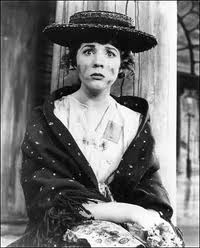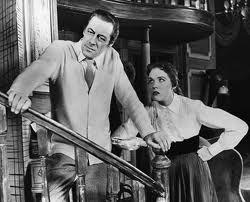The Broadway musical My Fair Lady is considered to be one of the greatest American musicals and Julie Andrews portrayal of Eliza Doolittle is what made her a star. My Fair Lady premiered on Broadway at the Mark Hellinger Theatre (it is now the inter-denominational Times Square Church) on March 15, 1956. Based on the play Pygmalion by George Bernard Shaw, My Fair Lady, which ran for 2,717 performances, featured music by Frederick Lowe and lyrics and book by Alan J. Lerner. After playing at the Hellinger, it transferred to the Broadhurst Theatre and then ended its run at the Broadway Theatre on September 29, 1962. When it closed it had set the new record for Broadway runs.
There are three performers who gave legendary performances in that first production of My Fair Lady- Julie Andrews, Rex Harrison and Stanley Holloway. Today we focus on the only one who did not make the transfer from stage to the screen version of this classic musical- Julie Andrews.
Perfect as Eliza?
It’s said that some people had their doubts about Julie Andrews playing Eliza Doolittle, including her co-star Rex Harrison. Apparently Andrews had a rough start in the rehearsal process as she struggled with the cockney accent and also with her characterization. Harrison is reported to have said at one point, “If that girl is here on Monday giving the same goddamn performance, I am out of this show!” Andrews came around, Harrison stayed and legends were made. Was Andrews the perfect Eliza Doolittle? She certainly seemed to be.
In her performance, she was genuine to the core. That can be seen in her number “Loverly” where she wins the hearts of those in the chorus and audiences. “Loverly” would become a signature song for Andrews. There was something stunningly pure in Andrews’ Eliza Doolittle. She was a wisp of a thing but one that had power and nerve. She proved to be a fine singer who could certainly act her numbers. She was not your mega-voiced leading lady like Ethel Merman, or stunning, vibrant dancer/actress like Gwen Verdon, or brash and grounded presence like Mary Martin.
Andrews in Rehearsal
Julie Andrews somehow seemed simply “to be” on stage in a quiet, confident manner. She possessed elegance even as that downtrodden, low class waif Eliza Doolittle. Energy, focus and drive were all there but they always seemed to be a controlled and subdued. You wanted to see more of her just to see what more there was to see.
Tony Noms and After
Andrews singing “Show Me.”
In 1957, only the second year that the Tonys featured nominees, as from 1947-1955 they simply presented the award without a nominating process, Julie Andrews was nominated for Best Leading Actress in a Musical along with Ethel Merman (Happy Hunting) and Judy Holliday (Bells Are Ringing). Holliday won. After her run on Broadway, Andrews landed the role of Cinderella in Rodgers & Hammersteins’ musical of the same name. That musical was specifically written to be aired on CBS-TV. After that it was Camelot on Broadway and Mary Poppins and Maria (Sound of Music) on film and Julie Andrews was a huge star.


